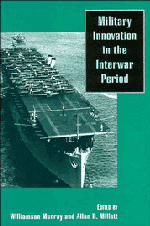Crossref Citations
This Book has been
cited by the following publications. This list is generated based on data provided by Crossref.
Mahnken, Thomas G.
1999.
Uncovering foreign military innovation.
Journal of Strategic Studies,
Vol. 22,
Issue. 4,
p.
26.
Roxborough, Ian
2006.
Learning and Diffusing the Lessons of Counterinsurgency: The U.S. Military from Vietnam to Iraq.
Sociological Focus,
Vol. 39,
Issue. 4,
p.
319.
Hinks, John
2007.
FM: the innovation imperative.
Facilities,
Vol. 25,
Issue. 11/12,
Hinks, John
Alexander, Martin
and
Dunlop, Graham
2007.
Translating military experiences of managing innovation and innovativeness into FM.
Journal of Facilities Management,
Vol. 5,
Issue. 4,
p.
226.
Murray, Williamson
2008.
The Making of Peace.
p.
208.
Ahlstrom, David
Lamond, David
and
Ding, Zhujun
2009.
Reexamining some management lessons from military history.
Asia Pacific Journal of Management,
Vol. 26,
Issue. 4,
p.
617.
Redford, Duncan
2009.
Inter- and Intra-Service Rivalries in the Battle of the Atlantic.
Journal of Strategic Studies,
Vol. 32,
Issue. 6,
p.
899.
Ahlstrom, David
and
Wang, Linda C.
2009.
Groupthink and France's defeat in the 1940 campaign.
Journal of Management History,
Vol. 15,
Issue. 2,
p.
159.
Gladman, Brad William
2009.
Intelligence and Anglo-American Air Support in World War Two.
p.
1.
Castaldi, Carolina
Fontana, Roberto
and
Nuvolari, Alessandro
2009.
‘Chariots of fire’: the evolution of tank technology, 1915–1945.
Journal of Evolutionary Economics,
Vol. 19,
Issue. 4,
p.
545.
Farrell, Theo
2010.
Improving in War: Military Adaptation and the British in Helmand Province, Afghanistan, 2006–2009.
Journal of Strategic Studies,
Vol. 33,
Issue. 4,
p.
567.
Alexander, Martin S.
2011.
‘[…] the best security for London is the nine Kennedy children.’ Perceptions by US Officials in Washington DC and London of Britain's Readiness for War in 1939.
Contemporary British History,
Vol. 25,
Issue. 1,
p.
101.
Mahnken, Thomas G.
2011.
China's Anti-Access Strategy in Historical and Theoretical Perspective.
Journal of Strategic Studies,
Vol. 34,
Issue. 3,
p.
299.
2011.
War, Strategy, and Military Effectiveness.
p.
14.
2011.
Military Adaptation in War.
p.
1.
2011.
Military Adaptation in War.
p.
74.
Calhoun, Mark T.
2011.
Unifying Themes in Complex Systems.
p.
73.
2011.
Military Adaptation in War.
p.
37.
2011.
Military Adaptation in War.
p.
119.
2011.
War, Strategy, and Military Effectiveness.
p.
139.





